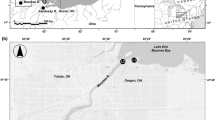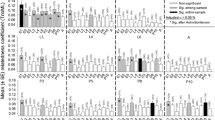Abstract
Lake sturgeon Acipenser fulvescens populations have experienced declines throughout much of the Great Lakes. Understanding key demographic characteristics about lake sturgeon populations can help identify potential limiting factors to their recovery. Within a single spawning season, there may be multiple spawning events, which could affect genetic diversity of the resulting cohort. Our objective was to determine whether multiple discrete spawning events resulted in a larger effective number of breeders and higher genetic diversity. Larval samples were collected following the spawning periods in 2005 (n = 479) and 2006 (n = 279). In 2005, there were two discrete spawning events and a longer spawning season; in 2006, the spawning events were less discrete and the spawning season was shorter. Genetic samples from larval sturgeon were analyzed at 12 microsatellite loci. The effective number of breeders (Nb), genetic diversity (observed heterozygosity, expected heterozygosity, allelic richness, inbreeding coefficient), and relatedness were measured for each cohort. The effective population size (Ne) and genetic diversity were also measured in the adult population (n = 85). The larval cohorts had a high Nb (2005: 54; 2006: 73) relative to the Ne of the adult population (Ne = 28). Multiple spawning events did not result in more breeders, but did result in lower relatedness among the resulting offspring. Therefore, environmental factors should be maintained that encourage an extended spawning season, increasing the likelihood of multiple spawning events and decreasing the relatedness among individuals in the cohort.



Similar content being viewed by others
References
Auer N (1996) Response of spawning lake sturgeon to change in hydroelectric facility operation. Trans Am Fish Soc 125:66–77
Auer N (2004) Conservation. In: LeBreton GTO, Beamish FWH, McKinley RS (eds) Sturgeons and paddlefish of North America. Kluwer Academic Publishers, Massachusetts, pp 252–276
Auer NA, Baker EA (2002) Duration and drift of larval lake sturgeon in the Sturgeon River, Michigan. J Appl Ichthyol 18:557–564
Bruch RM, Binkowski FP (2002) Spawning behavior of lake sturgeon (Acipenser fulvescens). J Appl Ichthyol 18:570–579
Caroffino DC, Sutton TM, Elliott RF, Donofrio MC (2010) Early life stage mortality rates of lake sturgeon in the Peshtigo River, Wisconsin. N Am J Fish Manag 30:295–304
Christie MR, Johnson DW, Stallings CD, Hixon MA (2010) Self-recruitment and sweepstakes reproduction amid extensive gene flow in a coral-reef fish. Mol Ecol 19:1042–1057
Do C, Waples RS, Peel D, Macbeth GM, Tillet BJ, Ovenden JR (2013) NeEstimator V2: re-implementation of software for the estimation of contemporary effective population size (Ne) from genetic data. Mol Ecol Res 14:209–214
Duong TY, Scribner KT, Forsythe PS, Crossman JA, Baker EA (2013) Interannual variation in effective number of breeders and estimation of effective population size in long-lived iteroparous lake sturgeon (Acipenser fulvescens). Mol Ecol 22:1282–1294
Flowers JM, Schroeter SC, Burton RS (2002) The recruitment sweepstakes has many winners: genetic evidence from the sea urchin Strongylocentrotus purpuratus. Evolution 56:1445–1453
Forsythe PS, Scribner KT, Crossman JA, Ragavendran A, Baker EA, Davis C, Smith KK (2012a) Environmental and lunar cues are predictive of the timing of river entry and spawning-site arrival in lake sturgeon Acipenser fulvescens. J Fish Biol 81:35–53
Forsythe PS, Crossman JA, Bello NM, Baker EA, Scribner KT (2012b) Individual-based analyses reveal high repeatability in timing and location of reproduction in lake sturgeon (Acipenser fulvescens). Can J Fish Aquat Sci 69:60–72
Frankham R (1995) Conservation genetics. Annu Rev Genet 29:305–327
Friday MJ (2005) The migratory and reproductive response of spawning lake sturgeon to controlled flows over Kakabeka Falls on the Kaministiquia River, ON 2005. Ontario ministry of natural resources upper great lakes management unit technical report 05.01
Friday MJ (2006) The migratory and reproductive response of spawning lake sturgeon to controlled flows over Kakabeka Falls on the Kaministiquia River, ON 2006. Ontario ministry of natural resources upper great lakes management unit technical report 06.02
Friday MJ, Chase ME (2005) Biology and management of lake sturgeon (Acipenser fulvescens) in the Kaministiquia River. Ontario ministry of natural resources upper great lakes management unit technical report
Goudet J (2001) FSTAT, a program to estimate and test gene diversities and fixation indices (version 2.9.3). Available from http://www2.unil.ch/popgen/softwares/fstat.htm. Accessed 18 November 2013
Harkness WJK, Dymond JR (1961) The lake sturgeon. Report to Ontario department of lands and forests. Fish and Wildlife Branch, Toronto, p 97
Hedgecock D (1994) Does variance in reproductive success limit effective population size of marine organisms? In: Beaumont AR (ed) Genetic and evolution of aquatic organisms. Chapman and Hall, London, pp 122–134
Hedgecock D, Launey S, Pudovkin AI, Naciri Y, Lapègue S, Bonhomme F (2007) Small effective number of parents (N b ) inferred for a naturally spawned cohort of juvenile European flat oysters Ostrea edulis. Mar Biol 150:1173–1182
Hill WG (1981) Estimation of effective population size from data on linkage disequilibrium. Genet Res 38:209–216
Kempinger JJ (1988) Spawning and early life history of lake sturgeon in the Lake Winnebago system. In: Hoyt RD (ed) 11th annual larval fish conference, symposium 5. American Fisheries Society, Maryland, pp 110–122
LaPan SR, Klindt RM, Johnson JH, Schiavone A (2000) Lake sturgeon spawning on artificial habitat in the St. Lawrence River. In: Brooking TE (ed). Update on lake sturgeon in New York waters, New York, p 7
Nicols SJ, Kennedy G, Crawford E, Allen J, French J III, Black G, Blouin M, Hickey J, Chernyák S, Haas R, Thomas M (2003) Assessment of lake sturgeon (Acipenser fulvescens) spawning efforts in the lower St. Clair River, Michigan. J Great Lakes Res 29:383–391
Peakall R, Smouse PE (2006) GenAlEx 6: genetic analysis in excel. Population genetic software for teaching and research. Mol Ecol Notes 6:288–295
Peterson DL, Vecsei P, Jennings CA (2007) Ecology and biology of the lake sturgeon: a synthesis of current knowledge of a threatened North American Acipenseridae. Rev Fish Biol Fish 17:59–76
Queller DC, Goodnight KF (1989) Estimating relatedness using genetic markers. Evolution 43:258–275
Robinson JD, Moyer GR (2013) Linkage disequilibrium and effective population size when generations overlap. Evol Appl 6:290–302
Scott WB, Crossman EJ (1973) Freshwater fishes of Canada. Bulletin 184 fisheries research board of Canada, Ottawa, pp 966
Smith KM, King DK (2005) Dynamics and extent of larval lake sturgeon Acipenser fulvescens drift in the Upper Black River. J Appl Ichthyol 21:161–168
Trested DG, Isely JJ (2011) Age, growth, mortality, and abundance of lake sturgeon in the Grasse River, New York, USA. J Appl Ichthyol 27:13–19
Waples RS (2006) A bias correction for estimates of effective population size based on linkage disequilibrium at unlinked gene loci. Conserv Genet 7:167–184
Waples RS, Do C (2008) LDNE: a program for estimating effective population size from data on linkage disequilibrium. Mol Ecol Resour 8:753–756
Waples RS, England PR (2011) Estimating contemporary effective population size on the basis of linkage disequilibrium in the face of migration. Genetics 189:633–644
Waples RS, Luikart G, Faulkner JR, Tallmon DA (2013) Simple life-history traits explain key effective population size ratios across diverse taxa. Proc R Soc B 280:20131339
Welsh A (2004) Factors influencing the effectiveness of local versus national protection of migratory species: a case study of lake sturgeon in the Great Lakes, North America. Environ Sci Policy 7:315–328
Welsh A, May B (2006) Development and standardization of disomic microsatellite markers for lake sturgeon genetic studies. J Appl Ichthyol 22:337–344
Welsh A, Hill T, Quinlan H, Robinson C, May B (2008) Genetic assessment of lake sturgeon population structure in the Laurentian Great Lakes. N Am J Fish Manag 28:572–591
Wright S (1938) Size of population and breeding structure in relation to evolution. Science 87:430–431
Acknowledgments
Thanks to Karen Schmidt (OMNR) and summer staff for sample collection and Ontario Parks for allowing us to carry out the field component of this research in the park. John Pedroia and Lindsay Clark provided laboratory assistance. Thanks to Andrea Schreier for providing valuable feedback on our manuscript.
Author information
Authors and Affiliations
Corresponding author
Rights and permissions
About this article
Cite this article
Welsh, A.B., Baerwald, M.R., Friday, M. et al. The effect of multiple spawning events on cohort genetic diversity of lake sturgeon (Acipenser fulvescens) in the Kaministiquia River. Environ Biol Fish 98, 755–762 (2015). https://doi.org/10.1007/s10641-014-0309-9
Received:
Accepted:
Published:
Issue Date:
DOI: https://doi.org/10.1007/s10641-014-0309-9




